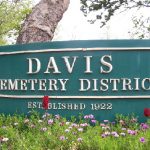| Enjoy a stroll through history one of our Davis Cemetery District History Tours.
The historic cemetery district is offering guided history tours on our beautiful grounds. We will share the stories of the pioneer families and individuals who have shaped our city into what it is today. We will also discuss the meaning of and changes to gravestone symbols from Victorian times to the present. Tours will take about a 1 hour. Wear comfortable shoes. Guided cart tours are available but will be limited to three individuals. |
News
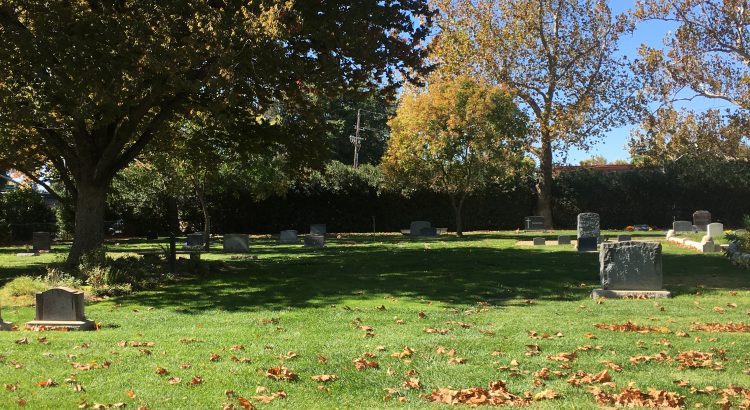
Historic J Section – ON SALE NOW
J Section Expansion – ON SALE NOW
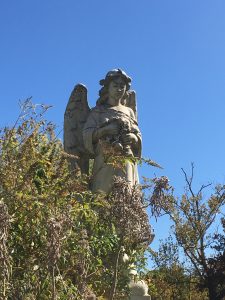 The Davis Cemetery District is pleased to announce we have added a new expansion section to our beautiful cemetery. Originally gifted to the catholic Church in 1874 by Mrs. I.S. Chiles, J section is a cornerstone of the cemetery. While the District does not inter by religion, J section is known as the historic catholic section. The new plots are beautifully shaded by a mature Japanese Zelkova which is surrounded by miniature roses, African daisies, and Foxtail ferns. This section offers both casket and large cremation plots and will accommodate cremation, standard, green, and titan burials.
The Davis Cemetery District is pleased to announce we have added a new expansion section to our beautiful cemetery. Originally gifted to the catholic Church in 1874 by Mrs. I.S. Chiles, J section is a cornerstone of the cemetery. While the District does not inter by religion, J section is known as the historic catholic section. The new plots are beautifully shaded by a mature Japanese Zelkova which is surrounded by miniature roses, African daisies, and Foxtail ferns. This section offers both casket and large cremation plots and will accommodate cremation, standard, green, and titan burials.
Stop by 820 Pole Line Road or call (530) 756-7807 to reserve your plot(s) today. The Davis Cemetery offers a pre-need program and fiscal year financing options. Entering into a pre-need contract is the best way to assure your burial wishes are followed.
J Section Expansion Pricing
$2,500 Casket Plot (Plot and Endowment)
$1,400 Large Cremation Plot (Plot and Endowment)
WE ARE UNDER CONSTRUCTION!
The Davis Cemetery District is pleased to announce that we have broken ground on a section expansion which will bring 68 new casket plots and 12 double cremation plots to our historic J section. Under direct supervision of the Grounds Foreman, Matt Ries, our grounds crew has been demolishing an old hearst turnaround pad to make way for the new plots in the highly desirable historic section of the cemetery. Dylan Weiss is managing backhoe operations while Daniel and Sawyer are the eyes and muscle on the ground as the concrete is pulled in sections and placed in concrete recycling containers. A big thank you to Recology for being so accommodating with our concrete disposal schedule.
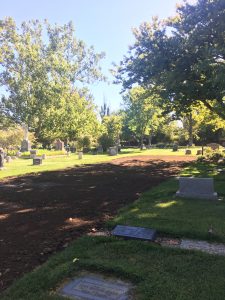 July 24th UPDATE
July 24th UPDATE
The J section expansion is coming along nicely. Our dedicated grounds crew have rerouted irrigation and graded the area. We will be seeding the plots over the next week and are on track to begin selling the plots September 1, 2019.
August 8th UPDATE
The grass is coming in nicely and we are on schedule to open sales September 1, 2019.
August 21st UPDATE
The Board reviewed an initial pricing structure proposal on August 21st and will set pricing at the September 18th meeting. Plots will be available for sale beginning October 1, 2019.
Past Exhibitions
Anne Lincoln Solo Exhibition “Passages”
Anne Lincoln “Passages”
Art Exhibition: November 3-November 30th
Art Reception: November 5th from 1-4:00 pm
Acclaimed painter Anne Lincoln will exhibit her latest collection of landscape paintings at Gallery 1855 (820 Pole Line Road, Davis, CA) throughout the month of November. A special fall afternoon artist reception will be held Sunday, November 5th from 1-4:00 pm. “Passages” masterfully captures the colors and atmosphere of the local California landscape from the Yolo Bypass to the rocky coast. Anne has an uncanny ability to capture the color harmonies found in nature. She carefully selects patterns of light, value, and color creating a sense of light and space.
“While passages can mean a path or journey, it can can also refer to a detail in a work of art. A sense of a voyage, of finding my way from soft colors and a realistic approach to a more saturated, layered palette with simplified shapes, has been my road to travel in this show.
The beginning of a more specific idea, that of movement either in style or color or subject probably started back in the 1980’s while I was driving a lonely stretch of highway from the flats of Bakersfield to the rocky shore of Morro Bay. The winding and dipping of the road reminded me of the ribbon striped candy by Grandfather would give to me at Christmas. I’ve always thought of that trip as the Ribbon Candy Road adventure, and it is the inspiration for my painting of that name which is in this show. For me, “Passages” will bring back fond memories as well as remind me of the ups and downs and new challenges a painter will experience.” Anne Lincoln
Anne Lincoln is originally from Gary, Indiana but moved to California in her teens. She has called Davis her home for the past forty-years. She has experimented with different art mediums over the years, but she found her true passion in oil painting eight years ago. Anne paints on thick birch panels specially made in Oregon. The wood is prepared with a minimum of five layers of surface preparation before the first stroke of color.Anne work has been shown in many local gallery exhibitions such as Davis Art Center, Pence Gallery, I-House, Hallmark Inn, Yolo Basin Foundation and many others. Her works have also been included in many corporate and private collections. More details about the artist can be found at www.annelincoln.com.
Gallery 1855 is a non-profit contemporary art gallery located at the scenic Davis Cemetery District. A full listing of events can be found at www.daviscemetery.org
Reflect and Repeat: Images from the Gladding, McBean Factory Photographs by Gene Kennedy
Join us Sunday, October 15th for the opening reception for photography Gene Kennedy. His solo exhibition “Reflect and Repeat: Images from the Gladding, McBean Factory” will run throughout the month of October. Come meet the artist, enjoy his works and experience the most unique gallery location in town. The afternoon artist reception will include a free concert with the New Harmony Jazz Band.
Gene Kennedy has been photographing for more than forty-five years. He gained recognition nationally for his photography of the evolving California Landscape. Regionally I am known as a photography of the evolving California landscape. Regionally he is celebrated as a photographer, teacher, gallery, administrator and former director of the popular Gladding McBean Photography Workshops.
Gene’s photographic projects have focused on the man-impacted environment, with a few nods of appreciation to the natural world, and the occasional touch of humor. His documentary-style landscape reside in the collections of the California State Library, the San Francisco Museum of Modern Art, and the Museum of Modern Art in New York, among others.
“It makes sense in a place whose job is to make multiple identical copies of products, ranging from roof tiles to gigantic sewer pipes to delicate figures for architectural decoration that pictures made in that place might also reflect the same repetitious quality. That is, repetitious in the best sense of the word. Such was my intent in selecting the images for this show. Most of them have never been exhibited before, but a few old favorites also appear.
The Gladding, McBean & Co. factory, in the Placer County town of Lincoln, opened in 1875 and has operated continuously since then, surviving two World Wars and the Great Depression. Starting as a clay pipe manufacturer, “the pottery” expanded its product line and by the end of the 19th century was producing architectural Terra cotta ornamentation for buildings, most notably after the 1906 San Francisco earthquake. Ernest Hopkins, columnist for the San Francisco Examiner, said in July, 1928: “From a hole in the ground, here in the lower end of Placer County, the modern city of San Francisco has come.” (Not to mention thousands of other buildings in San Diego, Los Angeles, Sacramento, Portland, and Seattle, and places as far-fetched as New York, Chicago, Tokyo and London.
I was privileged to be able to organize and lead photographic workshops at Gladding, McBean for 16 years. Close to 300 enthusiastic photographers made it into the pottery during that time, and many of them came back time after time after time, simply because they weren’t finished taking pictures there. If we had been able to continue after 2011, I’m sure many of them would have come back again.
I’m sure all those photographers would join me in expressing their sincere gratitude to the workers and management of Gladding, McBean for the extraordinary gift of being allowed to visit and photograph this magical place.”
Gallery 1855 is located at the historic Davis Cemetery District office at 820 Pole Line Road, Davis, CA. . It is a non-profit community space that celebrates local artists as well it’s unique history. For more information about upcoming exhibitions please go to www.daviscemetry.org.
Sukhee Kwon “Artist Abundance” Mixed Media Art Exhibition
Gallery 1855 (located at 820 Pole Line Road) is pleased to announce the solo exhibition of artist Sukhee Kwon from September 8-September 30th. The special artist reception with light refreshmentss will be held September 10th from 1-4:00 pm.
Sukhee is known for her colorful abstract works painted on a variety of mediums such as fans. The vibrant florals and powerful brush work will capture the imagination of the audience.
Born in Korea in the 1950’s, Sukhee grew up playing among wild flowers and war remnants while dreaming of living in America as an artist. After a lifetime of turns and tribulations purusing her art, she now lives in America as an artist.
As a contribution to the artists of the world, she created an international Fine Arts Collaborative to promote artists, their works new attitude, new cliché “Artist Abundance!” and to educate parents of young children with dreams.
Gallery 1855 is a non-profit art gallery located at the historic cemetery district office. Visitors are welcome to view the art Monday-Friday from 9-3:00pm and on the Second Sunday of every month from 1-4:00pm.
More details on this show and a calendar of upcoming events can be found at www.daviscemetery.org

The Places We Built Solo Exhibition of Nicole Seisler
Gallery 1855 (820 Pole Line Road, Davis, CA) is pleased to announce the solo exhibition of artist Nicole Seisler. The exhibition will run from August 12-August 31st and will have an opening reception August 13th from 1-4:00pm. Nicole Seisler is an interdisciplinary artist who creates sculpture, installation, and public art that investigate themes of time, ephemerality, and the overlapping roles of artist/viewer/participant/collaborator.
The Places We Built is a new layer of Nicole Seisler’s ongoing project, Hand Pressed Souvenirs, which integrates social practice, ceramics, and the use of walking as an art-making tool. The project uses clay as the conceptual and material conduit for forging tangible, intimate connections between people and the places in which they live, work, and travel. Nicole uses customized field kits to bring blocks of wet porcelain on walks throughout neighborhoods where participants use the malleable material to make impressions of architectural details that visually and culturally define a place. These Hand Pressed Souvenirs, much like clay tablets of the earliest societies, become records of particular moments in history. One side of each ceramic object shows sharp details of architecture and design while the other side retains the lines and marks of the hand that produced it. The space between people and place is literally embodied by the raw clay and, once fired, it is permanently solidified. The growing collection of Hand Pressed Souvenirs maps our global cities and spaces through personal connections, stories, and memories.
Nicole’s exhibition at Gallery 1855 is a new iteration of this archival mapping process. Using the porcelain souvenirs as molds, Nicole casts new compositions in handmade paper, thereby forming fresh connections amongst the seven year old collection of souvenirs. This body of work serves as memories of memories, an archive of an archive of our shared experiences of place.
Nicole received her MFA from the School of the Art Institute of Chicago and her BFA from the School of the Museum of Fine Arts, Boston. She has exhibited her work at international venues including the Museum of Contemporary Photography, Chicago; Elmhurst Art Museum, Illinois; Museum of Fine Arts, Boston; Museum of Fine Arts, Tallahassee; Armory Arts Center, West Palm Beach; NEXT Art Fair, Chicago; Alto Galleria, Brussels; and Flash Atoyle in Izmir, Turkey. Reviews of Nicole’s work have been published in The New York Times, Hyperallergic, Ceramics Monthly, the Boston Globe, the Boston Herald, and the Palm Beach Arts Paper. Nicole has been awarded the City of Boston Public Art Grant, the Fort Point Arts Community Public Art Fund, and she received the Maria Scholarship for her residency with ACRE Projects. Nicole has taught ceramics part-time at the School of the Art Institute of Chicago and Lake Forest College, and full-time at the University of Washington. She is currently the Lincoln Visiting Professor of Ceramics at Scripps College in Claremont, CA.
Gallery 1855 is a non-profit art gallery located at the Davis Cemetery District office at 820 Pole Line Road, Davis, Ca. For more details on this event and other please go to www.daviscemetery.org.

Show and Tell Open Mic
Davis Cemetery District and Arboretum (820 Pole Line Road, Davis) will host its first ever open-mic event modeled after your favorite elementary school activity “Show and Tell” on August 12th starting at 11:00 am.
Davis Cemetery District and Arboretum has a long history of celebrating the stories and history of the community. We have partnered with professional memoir writer Emma Fulenwider. Emma hosts Show and Tell events throughout the Sacramento area as a fun way to promote memoir writing in the community.
“A lot of people want to write their life experiences down, but they are intimidated by the writing process and they don’t know where to start. Show and Tell is a great starting point because there is no writing involved, people choose a special story from their life and tell it to others.”
Participants are encouraged to bring items of special personal significance and come prepared to show their treasure and tell the story behind it.
“This isn’t Antiques Road Show, don’t bring the oldest or most valuable thing in your home. Bring something that is special to you for a reason that only you know about.”
This event will coincide with our Davis Cemetery District history weekend. Which will include a self-guided tour made up of the personal histories of its residents and an art opening by ceramic artist Nicole Seisler who’s work features hand pressed ceramics that tell a story of her life and travels.
For event details, visit the Davis Cemetery District is a historic cemetery that offers community events that celebrate the art and culture of our diverse community. Visit our event calendar at http://www.daviscemetery.org or contact Emma Fulenwider at emma@cedarpen.com for additional details.
*Thoughts and opinions expressed by guests at our community events are not representative of the Davis Cemetery District, staff or Board of Trustees.

Davis Waldorf School Student Art Exhibition
Gallery 1855 is pleased to announce a special exhibition featuring the talented students of the Davis Waldorf School This exhibition will feature work from Davis Waldorf students 1-8 entitled “Connecting with the Natural World Through the Eyes of A Child”. The exhibition will run from July 1-July 30th and the opening reception will be held Sunday, July 9th from 1-4:00pm. The opening will include a free performance from the Davis Waldorf Fiddlers.
A deep appreciation for nature is expressed in this art exhibit which shows that every child is an artist everyone has their own unique connections to nature. The display ranges from second grade to eight grade, using chalk drawings, beeswax crayon art, charcoal drawings, and watercolor paintings. As you peruse the artwork, enjoy the individual details each child adds to their work. The display includes the work of the seventh graders who have studies briefly about social justice and the human rights movements, which they will explore in depth in eighth grade. They each chose a quote from Dr. Martin Luther King Jr’s I Have a Dream speech to enhance their paintings of the red hills of Georgia.
Gallery 1855 is a premiere non-profit art gallery featuring contemporary art. It is located at the Davis Cemetery District office.

“Hand of Man” F/8 Photography Group Exhibition
Gallery 1855, 820 Pole Line Road, announces the F/8 photography group art exhibition featuring local artists Anne Miller, Dave L. Robertson, Richard Haliburton, Dennis McCoy, Joseph Finkleman, Tim Messick, Rob Floerke and Michael Radin.
The collection, centering on the theme “Hand of Man,” will run throughout June. The show features each artists’ interpretation of the theme. Davis artist Tim Messick photographed man-made things that have been altered somewhat by time and the elements. Photographer Anne Miller’s work started with a man-made surface and the work ultimately becomes something else in her treatment of the subject. While nature enthusiast Robert Floerke’s images explore the past and mystery of the “Ancient Ones’ or Anasazi.
A free artists reception will be held Sunday, June 11th, from 1 to 4 p.m. The show is inspired by the 1930s’ famous group of photographers that lived in and around San Francisco that called themselves the F/64 club. It wasn’t that they actually used this very small f/stop but rather it was the idea of infinite depth of field that intrigued them. Before, for decades, photography had many adherents to a romantic soft-focus or selective-focus style. Using a small aperture meant that there wasn’t a specific obvious plane of focus, thus the viewer could make their own choice on what was important to them about the image and not be told by the photographer where to look.
It is in this spirit that this group of largely Yolo County photographers have come together to critique each other’s work. The eight artists all have different interests and visions, but one common passion is to perfect and develop their specific talents.
All ages are welcome and encouraged to visit the gallery, located on the grounds of the Davis Cemetery. For more information, visit www.daviscemetery.org
June 2017 “Hand of Man” by F/8 Photography Group
Summertime Group Art Exhibition
Shake off those winter doldrums with our first annual “Summertime” exhibition. Artists from all mediums have shared their interpretation of this wonderful season. Exhibition will run from May 4th-May 31st. The reception will be held on Sunday, May 21st from 1-4:00 pm. Grab a friend and enjoy an afternoon of delightful work from some of your favorite artists.
Featuring: Linda Ayre, Mary Ellen Bauer, Koel Breslin, Pearl Caysentes, Simon Dvorak, Dalia Frank, Donald Hartman, Mark Howell, Charles V. Mcdonald, Mary Ann Montague, Barbara Mortkowitz, Diane Mohar, Cathie James-Robinson, Lin Lindert, Ann Privateer, Marguerite Schaffron, Susan Scholey, Cathy Speck, Crystal Vagnier, and Thelma Weatherford and Linda Ziskind!

March 2017
Thelma Weatherford
Exhibition: March 1-March 30th
Opening Reception: Sunday March 12th 1-4:00pm
Gallery 1855 is pleased to announce the solo exhibition of Davis artist Thelma Weatherford. The Abstractions of Nature exhibition will feature her latest works and will run throughout the month of March. There will be an artist reception with light refreshments on Sunday, March 12th from 1-4:00pm. The show will consist of paintings that are small abstract snap shots of nature such as gardens, plants, flowers, water, some are subtle others have movement and bright colors. There is a mixture of oil and cold wax as well as encaustics.
My work has evolved over the years; currently I have been working with encaustics and oil & cold wax. In my process I experiment with layering, scraping and mark – making. I usually start with a general idea or color scheme. After I apply several layers and manipulate the paint I allow the piece to guide me, to “tell” me where it wants to go. It takes several days or weeks to get to this point. My work is about exploring what you can do by layering, adding & taking away layers of paint. I use various mark making tools to etch into the layers of paint. My work focuses on abstract style of art. Inspiration comes from nature and our environment. My observation of the world around me is my subject matter. Creative energy comes from trees, plants, leaves in the fall, water, mountains, beaches, and cityscapes. I play with color, texture, line, and form. Many of my paintings are impressions of small places such as leaves in a windstorm, poppies at night, maybe a riverbed with water flowing over rocks, or the patina of old wood. I am fascinated by the texture of buildings and structures. I use these elements from my environment to create abstractions or what I call mindscapes
Gallery 1855 is a non-profit contemporary gallery space located at the Davis Cemetery District (820 Pole Line Road). The public is invited to enjoy the work Monday-Friday and second Sunday from1-4:00pm. More details at www.daviscemetery.org

Gallery 1855 (820 Pole Line Rd, Davis, CA) is pleased to announce the solo exhibition by abstract photographer David Robertson. Death by Abstraction will be on exhibit throughout the month of February. A special artist reception which will include a talk with the artist will be held Sunday, February 12th from 1-4:00pm. The personal talk with the artist will start at 2:00 pm. David Robertson is a retired professor of English at UC Davis, where he was also a member of the Graduate Groups in Ecology and Geography. He was a member of the group of faculty who established the Program in Nature and Culture, and joined with other faculty and staff to bring the Putah Cache Bioregion Project into existence. His teaching and research centered around human responses to the natural world, as well as the Bible as literature and religion in general. Two books were the outcome of these interests, West of Eden: A History of the Art and Literature of Yosemite and Real Matter, a book about the writings and doings mainly of Gary Snyder, Jack Kerouac, Philip Whalen, and Mary Austin. Since the early 1970s he has been an active photographer of the natural and human worlds.
Gallery 1855 is a non-profit contemporary gallery located at the historic Davis Cemetery District. For more information please go to www.daviscemetery.org.

Gallery 1855 welcomes all to come see the magnificent photos taken by AP Photo Students at Da Vinci Charter Academy. “Through the Lens of a Teen” will be on exhibit throughout the month of January. A reception will be held Sunday, January 15th from 1-4:00pm. The show will feature multiple works from nine young photographers. The show will consist of both digital and silver gelatin prints and explore a variety of subject matters. All sales will go directly to the artists of the AP Da Vinci Art program.
The exhibit opens on January 2, reception Jan 15th and is open through rest of January. The gallery is located on 820 Pole Line Rd., Davis, Ca. Come support the next generation of artists.
Simon Dvorak Solo Exhibition: Nodes
Exhibition Dates: December 1-December 30, 2016
Artist Reception December 11, 2016 1-4:00pm
Gallery 1855 is pleased to announce the solo exhibition by multi-media artist Simon Dvorak. His solo exhibition “Nodes” will be exhibited throughout the month of December. A special end of the year opening reception will be held on Sunday, December 11th 1-4:00pm.
Simon Dvorak has shown his work in multiple mediums throughout the United States. His latest work is an exploration of networks. Nodes, connected and disconnected, forming a greater whole, exist as independent and yet dependent objects. Connected and energy can be transferred. Disconnected and the node exists independently. Electrical circuits, computer networks, your ‘Related Items’ have all manifested as a result of this paradigm.
“Through the vibrant medium of oil paint I have tried to visualize these concepts in diverse formats and styles. In a time of social networks aided by technology, examining the power and beauty of networks becomes imperative so that we may better understand their nature and potential impact of their forms.”
This will be a must see exhibition. All work for sale by the artists. More information about the artist can be found at http://www.simondvorak.com
 :
:
Joseph Finkleman “Odd Specie”
Finkleman is a versatile artist whose work has been exhibited both internationally and throughout the country. His latest work is a series of portraits highlighting the beauty and strangeness of the human species.
Born in Hollywood, Finkleman studied literature and journalism at Sacramento State, then transferred to the San Francisco Art Institute, where he earned his bachelor’s and master’s degrees in fine art.
He worked as a commercial photographer for more than 20 years, then established and ran an advertising company specializing in niche marketing. For the next two decades he held various positions, including executive and management responsibilities in business development, sales management, customer service and marketing in a variety of companies. He is credited with starting and running Gallery 1855 and also designing the Davis Cemetery Arboretum.
He started showing art in the late 1960s and has had numerous solo shows of both his paintings and photography. Additionally, he has been in more than 100 group shows. His work is in collections in Europe and throughout the United States.
Partnered with his wife Susan Finkleman, they have one book to their credit, “Torn Silk Picture Cloud Quilt,” along with two CDs of their two-voice poetry. He has been working with the composer Robert Vann on a chamber opera titled “You Who Know” and a song cycle ,“The Blank Page.” His current opera, “The Kaballah: Shanghai 1940,” is unfinished.

October 2016: Tribute to Francisco X. Alacron
Gallery 1855 located at the cemetery office of Davis Cemetery & Arboretum will hold an art exhibition “Dreamers ~ Altars, Words and Paintings” from October 1-October 31st. There will be a special opening reception on October 9th from 1-4:00pm. It will feature over 20 art pieces by artists: Maya Christina Gonzalez, Rene Castro, Juan Fuentes, Francisco Orrego, Jaime Montiel, Claudia D. Hernández, and Natalia Deeve Sossa; featuring the poetry by locally and internationally recognized Poet Francisco X. Alarcón. The opening reception on October 9th will include a reading by Escritores del Nuevo Sol Poets and others. Poet-Activist and Co-editor of “Poetry of Resistance: Voices for Social Justice” Odilia Galván Rodríguez, will serve as emcee for the event.
September 2016: Celebration of Life Group Exhibition
The Davis Cemetery and Arboretum will host its eighth annual Celebration
of Life Arts Festival from 1 to 4 p.m. Sunday, September 18th. The free
festival features live music and a group art exhibition featuring the works
of local artists in a variety of mediums. Light refreshments will be
served throughout the day.
The event will start with a live performance by the New Harmony Jazz
Band from 1-3:00 pm. They will play a variety of jazz tunes from classic
to modern.
The art exhibition will be on display at the on-site gallery from
September 1-September 30th and features photography, charcoal,
encaustic, and paintings from over thirty artists.
The Davis Cemetery is as 820 Pole Line Road. For more information, call
530-756-7807, email is cemetery@dcn.org or visit www.daviscemetery.org.

August 2016
Kurt Fishback : Nature Mandalas
Gallery 1855 is pleased to announce the solo exhibition “Nature Mandalas” by renowned photographer Kurt Fishback. The exhibition will run throughout the month of August. A special artist reception will be held Sunday, August 14th and will include a special talk by the artist from 1-1:30 pm.
From the Indian language Sanskrit meaning Sacred circle, Mandalas are gateways to our divinity, the God within us from the human perspective and inspired by energy inherent in the Earth and Nature.
A mandala can be used during meditation as an object for focusing attention. The symmetry of the designs tends to draw the attention towards their center, towards our center.
In each Mandala natural elements have been incorporated from photographs made while walking on the Earth. Some of the elements include; trees, stones, grass, sand, water, air, clouds and sky. Light is the most important element, indicative of the energetic life force in everything.
Visages of animal and other spirits emerge in the production of the mandalas as a result of the juxtaposition of the natural elements used. They speak of our connection to the Sky Nation and to the individual medicines of Grand-father Sun, Grandmother Moon, the Thunder Beings, the Cloud People, all planets, galaxies, stars and solar systems.
These Mandalas were made as a part of my daily spiritual practice. Each mandala is available for individual interpretation and discovery of any
personal meaning specific to the individual viewer.
Kurt Edward Fishback, son of photographer Glen Fishback and name sake of photographer Edward Weston, grew up as part of the photographic community in Northern California during the 1940’s and 50’s. Mentors and friends of the family included Ansel Adams, Wynn Bullock, and Edward Weston. Despite his immersion in the world of photography, Fishback began his artistic career studying ceramic sculpture at Sacramento City College, the San Francisco Art Institute and the University of California, Davis in the 60’s. He first began to experiment with photography in 1962 as a way to document his experiences with other sculptors, but it was not until 1973, when his father invited him to teach at the Glen Fishback School of Photography, that photography became Fishback’s primary mode of expression. Since then he has gathered over 250 environmental portraits of artists in their studios or the space they chose.
Kurt continues to teach photography when he is not too busy maintaining his own artistic career. His first major, one-person exhibit was held at the San Francisco Museum of Modern art in 1982. Besides this Kurt has amassed an exhibition record of over 100 solo exhibitions and countless group exhibitions since 1961.
Learn more about the artist at his website.
July 2016

Adele Louise Shaw “Water, A Fluent Conversation”
Exhibition Dates July 2, 2015 -July 29, 2016
July 10, 2016 1-4:00pm
Gallery 1855 (820 Pole Line Road, Davis, CA) presents the solo exhibition of painter Adele Louise Shaw “Water: a fluent conversation”. The exhibition will run from July 1-July 30th with a special artist reception July 10th, 1-4:00pm.
The water references within the Tao the Ching by Lao Tzu are a strong influence in Shaw’s work. She says: Deeply rooted in the natural world, the Tao speaks an international language of spirit. It is with this same spirit my conversations with water carry on.
These paintings are created with inks and acrylics on paper. Shaw’s signature style uses calligraphic brushwork to draw in rhythm and form; tache brushwork to convey a sense of movement and flickering light: and action painting methods of pouring and trowing paint to transform energy and movement into multiple layers of abstraction. The large compositions envelop the viewer.
This exhibition presents paintings which are stirring, emotional surroundings to be in conversation with. They invoke multiple ideas of passion and longing, force and fury, the dance and the ecstasy. They are a homage to the spiritual truth that water conveys. These paintings invoke our universal emotional and physical connection to water, and connect the viewer to the subject with an elegant, sensual grace spoken with paint.
Small encaustic paintings are also part of the exhibition. Shaw has been working with encaustic paint for 18 years. Her work with encaustic continues to push the boundaries of this ancient medium.
The exhibition will be open to the public July 2 – 29, 2016 M-F 9-3:00pm. The artist will be present for an open house Sunday, July 10th, 1-4pm.
Learn more about the artist at her website here
June 2016
Dee Conway
Gallery 1855 located at the historic Davis Cemetery is pleased to present the solo exhibition of artist Dee Conway. “The Continuum” will run from June 1, 2016 – June 30, 2016 with an opening reception Sunday, June 12th from 1-4:00 p.m.
Dee Conway is a graduate of the B.A. Brooks Institute of Photography. She is an award winning artist whose work has been featured in many prestigious publications and galleries.
“The Continuum” is a personal project that is inspired by Conway’s friendship with her late mentor Johanna Gillman. Johanna Gillman was a fabulous New York artist who spent the last three years of her life in California. Many of the images in the exhibit are a combination of Gillman’s artwork with Conway’s paintings and photography.. In other works she changed the color, tone, or position of Gillman’s work to create something new. Many of the works explore unconventional painting and printing techniques. It is through this project that they can continue their art relationship.
“The Continuum” will run through June 30, 2016 at 820 Pole Line Road, Davis, Ca. The artist’s will be present at the opening reception Sunday, June12th from 1:00 – 4:00 p.m. Works will be for sale by the artist. Light refreshments will be served. Gallery hours are Monday through Friday 9– 4:00, and by appointment. For additional information www.daviscemetery.org
May 2016
Charlie Schneider
Exhibition Dates: May 1, 2015-May 30, 2016
Opening Reception: April 30, 2016
Multi-media experience interactive works located on the Davis Cemetery and Arboretum grounds in addition to photographs and imagery from artist Charlie Schneider.
December 2015
Seana Burke

November 2015
Kathryn Sylva

October 2015
Joseph Finkleman

September 2015
Christopher Dewees “Life Histories”

August 2015
David Best
July 2015
Ricardo Machado-Hernandez

June 2015
Da Vinci Charter Academy Advanced Placement Art Exhibition

May 2015
Celebration of Life Group Art Exhibition
April 2015
F/8 Photography Group “Windows and Doors”

March 2015
Steve Kiser

February 2015
Ellie Ivanova “Archive of Abandoned Dreams”

January 2015
Rob Stone “Close to Home”

December 2014
Andrea Stone

November 2014
Gene Kennedy


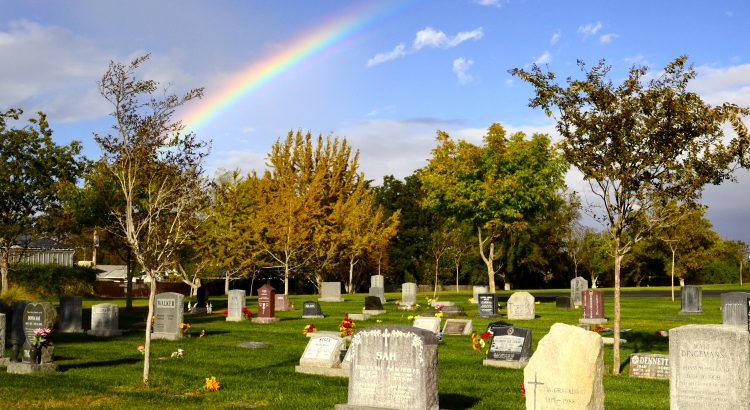
About the Davis Cemetery District
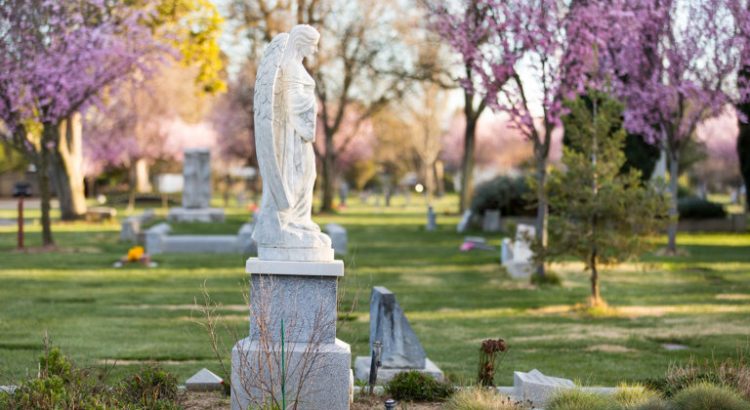
Cemetery Services
The Davis Cemetery District is a community tradition of historic natural beauty since 1855. We are committed to providing excellent service and beautiful environments to honor and remember loved ones. We serve all faiths and cultures, and we offer a wide range of options for memorializations.
A cemetery is a sanctuary and a place for friends and family to mourn, remember, and celebrate. Whether you are planning for the future or need to make immediate arrangements, we are here to educate and assist you with care and compassion. The Davis Cemetery honors the past, serves the present, and enriches the future.
A full list of services can be found here.
Davis Cemetery Arboretum Tree and Plant List
Davis Cemetery Arboretum Plants
 |
Flowering Maple (Abultilon)
Abutilon is a genus that includes 150 species. Some common names include Chinese Bell Flower, Chinese Lantern, Indian Mallow, and Flowering Maple. It is not related to maple but is called Flowering Maple because its leaves are shaped like a maple’s. The flowers hang down and are bell shaped. They can be white, yellow, pink, red, or orange and they can bloom continuously if the weather is warm enough. |
 |
Shoestring Acacia (Acacia stenophylla)
The Shoestring Acacia gets its name from its long, thin leaves, which resemble shoestrings. It has yellow flowers that bloom throughout the spring. Native to Australia, the Shoestring Acacia does well in desert environments. It tolerates saline and alkaline soils very well and can survive flooding. In Australia, the Shoestring Acacia is sometimes used for lumber and as a food source for some aboriginals. There are many common names for this tree in Australia, including Eumong, River Cooba, Belalie, and Gurley. |
 |
Autumn Blaze (Acer freemanii)
Also known as Freeman Maple, Autumn Blaze is the Jeffersred cultivar of a hybrid between Red Maple (Acer rubrum) and Silver Maple (Acer saccharinum). It has the best characteristics of each of its parent species. It has the Red Maple’s balanced, wide branches, and bright fall coloring and the Silver Maple’s drought and poor soil tolerance. The Autumn Blaze can reach a height of 50-60 feet and a branch span of 30-40 feet. In the fall its leaves turn bright red, orange, and yellow. The leaves also stay longer than the leaves of other types of Maple. |
 |
Big Leaf Maple (Acer macrophyllum)
The Big Leaf Maple, or Oregon Maple, is native to the west coast of North America. It has been known to reach 150 feet tall, but usually grows to 50-60 feet. The leaves, which are ½-1 foot across, are the largest of any maple species. These leaves become very colorful in the fall. Big Leaf Maple wood is often used for furniture and musical instruments, especially piano frames. Its sap can also be used to make maple syrup. It has a slightly different taste than Sugar Maple syrup, which is more common. |
 |
Red Maple (Acer rubrum)
The Red Maple, or Soft Maple, is one of the most common trees on the east coast of North America and it is the state tree of Rhode Island. It gets its name from the red flowers, seeds, twigs, and its bright red leaves in autumn. It is also known as the Swamp Maple or Water Maple because it is extremely tolerant of wet conditions and easily survives through floods. The leaves of the Red Maple are very toxic to horses, especially wilted or dead leaves. Not much is known about the toxin except that it damages red blood cells, making it harder to transport oxygen. |
 |
Bowhall Red Maple (Acer rubrum bowhall)
The Bowhall Red Maple is a cultivar of Red Maple. It grows to a height of 50 feet, but the branches only grow to a span of about 25 feet. Because of the narrower branches, this species is more convenient to plant in parking lots or along streets than other types of Maple trees. The seeds of this tree often attract squirrels and birds.
|
 |
October Glory (Acer rubrum October glory)
October Glory is a cultivar of Red Maple. It grows very quickly and has strong wood. It grows very well in wet conditions and has bright orange and red foliage in autumn.
|
 |
Red Sunset (Acer rumbrum red sunset)
Red Sunset, also called Scarlet Maple, is another cultivar of Red Maple. It grows fast and has strong wood. The roots are not very aggressive, so it does not raise sidewalks and cause other problems like other types of maple sometimes do. Red Sunset is one of the first trees to start changing colors in the fall and has bright red and orange foliage.
|
 |
Yarrow (Achillea)
Achillea is a genus that includes 85 species. Yarrow is the common name that most often applies to Achillea millefolium, but is also used for other species. These plants produce clusters of flowers at the tip of the stem. The flowers can be white, yellow, orange, red, or pink. Achillea was named for the mythological Greek hero Achilles. According to the Iliad, Achilles’ soldiers treated wounds with Yarrow. Because of this, Yarrow has also been called Allheal and Bloodwort.
|
 |
California Buckeye (Aesculus californica)
The California Buckeye is native to California and Oregon. Its bark, leaves, and nuts are toxic, but some Native American tribes were able to use the nuts as a food source by boiling them until the toxins were completely removed. The nectar of the California Buckeye also toxic to honeybees but is often eaten by butterflies.
|
 |
African Lily (Agapanthus)
African Lily is native to South Africa. Its stems grow two to six feet tall and have clusters of white, blue, or purple flowers that bloom in the summer.
|
 |
Peppermint Willow Myrtle (Agonis flexuosa)
The Western Australian Peppermint Tree, Swan River Peppermint Tree, or Peppermint Willow Myrtle is native to western Australia. It is very tolerant of heat and can grow in any kind of soil. The leaves, which smell like peppermint, can be dark purple to bright green, depending on the variety.
|
 |
African Mallow (Anisodontia julii)
Also known as Mountain Mallow and Bergroos, African Mallow is native to South Africa. In January and February, it produces purple flowers that look like hibiscus. They attract butterflies and bees.
|
 |
Manzanita (Arctostaphylos)
The name Manzanita comes from Spanish for ‘little apple.’ These shrubs are often planted for their beautiful flowers and berries and their smooth, red bark. Native Americans used the berries to make tea, cider, and jelly. They also used berries to make topical treatments for poison oak rashes, sores, and rheumatism.
|
 |
(Artemisia)
Artemisia is a genus of 200-400 species and is part of the daisy family. The name is derived from the Greek goddess Artemis. Common names of some species include Wormwood, Mugwort, and Sagebrush. The name Wormwood comes from the plant being used to treat worms. Other medicinal uses include treating poor circulation, fevers, colds, and digestive problems. Artemisinin is an extract from the species A. annua that is used in anti-malarial drugs. Some species of Artemisia are used in cooking, especially A. dracunculus, or Tarragon. Wormwood is mentioned several times in the Bible and in some Shakespeare plays. |
 |
Coyote Bush (Baccharis pilularis)
Coyote Bush is native to the southwest of North America. It is drought tolerant and has an extensive root system that allows it to take advantage of any available water in its very dry environment. It has also adapted to survive wildfires by re-growing from the roots after a fire has taken out the parts of the plant that are above ground. Coyote Bush is related to sunflowers, though they look nothing alike. Native tribes used the leaves of the Coyote Bush to reduce swelling and the branches to make arrows. |
 |
Kurrajong Tree (Brachychiton populus)
The Kurrajong is native to eastern Australia. It is a bottle tree, meaning that it has a swollen trunk which serves to store water in case of drought. Aboriginal people roasted and ate Kurrajong seeds and used the wood to make shields.
|
 |
Butterfly Bush (Buddleia)
The genus Buddleia was named for amateur botanist Reverend Adam Buddle in 1774 and contains over 100 species. They produce red, white, pink, purple, orange, or yellow flowers that are very fragrant and have lots of nectar, which attracts butterflies and hummingbirds.
|
 |
Bottlebrush Tree (Callistemon)
The Bottlebrush Tree is native to Australia. It gets its name from the long flowers that have red, yellow, or white spikes that make it look like a bottlebrush. It produces woody fruits that can be stimulated to open with fire.
|
 |
California Incense Cedar (Calocedrus decurrens)
The California Incense Cedar is native to western North America. Most wooden pencils are made with the wood of this tree because it is soft and can be sharpened without a lot of splintering. It has thick bark that protects it from wildfires. After a fire, wood wasps often lay eggs in the wood while it is still very hot.
|
 |
Deodar Cedar (Cedrus deodara)
Also known as Himalayan Cedar, the Deodar Cedar is native to the western Himalayas. It is the national tree of Pakistan. The name Deodar comes from a Sanskrit word meaning “wood of the gods.” The tree has been worshipped by Hindus and is often used to build temples. It is durable and resistant to rot, which makes it a good building material. The inner wood can be distilled to get essential oils. This oil is often used on the feet of horses, cattle, and camels to repel insects. It is also anti-fungal, so it can be used to preserve spices.
|
 |
California Lilac (Ceonothus)
There are many species of Ceonothus, which are native to California. They are very fragrant and have clusters of flowers that can be pink, white, purple, or blue. Deer like to eat Ceonothus because they have a lot of protein and calcium. Native Americans used to dry the leaves to make herbal tea and used the branches to make baskets.
|
 |
Palo Verde (Cercidium)
Palo Verde is native to the southwestern United States and Mexico and is the state tree of Arizona. It thrives in a desert environment and is extremely drought tolerant. The name Palo Verde, meaning ‘green stick’ in Spanish, comes from the tree’s green branches, limbs, and trunk. It has a very short flowering season in April and produces lots of yellow flowers, which attract pollinators like beetles, flies, and bees. Hummingbirds, doves, and other birds like to nest in the branches of this tree. |
 |
Western Redbud (Cercis occidentalis)
Also known as California Redbud, Western Redbud is native to California, Arizona, and Utah. It blooms from February to April, after a winter chill to stimulate the growth of its fragrant magenta flowers. Native Americans used the stems to weave baskets, the leaves to make incense, and the flowers, pods, and seeds as a food source.
|
 |
Desert Willow (Chilopsis linearis)
The Desert Willow is native to the southwestern United States and Mexico. It gets its name from the long, narrow, willow-like leaves. It has fragrant orchid-like flowers that can be pink, lavender, and sometimes white. Bees pollinate the flowers and birds eat the seeds. Hummingbirds often live on the Desert Willow. Unlike true willows, the Desert Willow has very strong wood, which made it perfect for Native Americans to use to make hunting bows.
|
 |
Chinese Fringe Tree (Chionanthus retusus)
The Chinese Fringe Tree is native to eastern Asia. It blooms in early spring with lots of fragrant white flowers. Female trees produce bluish fruits that are a food source for many birds.
|
 |
Cape Rush (Chondropetalum tectorum)
Cape Rush is native to South Africa. It grows in clumps and the stems can get up to three feet tall. In South Africa, Cape Rush is sometimes used for roof thatching.
|
 |
Camphor Tree (Cinnamomum camphora)
The Camphor Tree is an evergreen tree with waxy leaves, small white flowers, and small fruits that look like blackberries. It is native to China, Japan, Korea, and Vietnam. In the past, Camphor has been used for medicinal purposes such as sprains, minor heart issues, and mania, but it is no longer used in these ways. Because it can be easily absorbed through the skin and produces a cooling sensation, it is now used to sooth itching and is an active ingredient in products like [Vick’s VapoRub]. Camphor is also used to make incense and spices. However, it can be toxic to people if large amounts are ingested. |
 |
Gum Rockrose (Cistus ladanifer)
Also known as Laudanum, Common Gum Cistus, and Crimson-Spot Rockrose, the Gum Rockrose is native to the Mediterranean. It is tolerant of both drought and cold. The flowers it produces are white with a red or brown spot at the base, which is why it is sometimes called Crimson-Spot Rockrose. The whole plant is covered with a fragrant, sticky resin, which can be harvested for use in perfumes and other products. |
 |
Kousa Dogwood (Cornus kousa)
Kousa Dogwood is native to eastern Asia. It blossoms in late spring and the flowers attract lots of bees and butterflies. It also produces pink or red berries that are edible and are sometimes fermented to make wine. The fruit attracts lots of birds and squirrels. In autumn the leaves turn bright red.
|
 |
Turkish Hazel (Corylus colurna)
Turkish Hazel is native to Europe and Asia. It is the largest Hazel species. Because it is very tolerant of difficult growing conditions, this species is often planted in cities. Turkish Hazel produces edible nuts, but they are much smaller than common hazelnuts and have very tough shells that make them difficult to eat.
|
 |
Green-leaved Tamarind (Cupaniopsis anacardiodes)
Also known as Tuckeroo, Carrotwood, and Beach Tamarind, the Green-leaved Tamarind is native to Australia, Indonesia, and Papua New Guinea. It produces fruits which attract a lot of birds and small mammals. It grows very well in coastal environments and has become an invasive species in some areas of the United States, including Florida and Hawaii. |
 |
Italian Cyprus (Cupressus sempervirens)
Italian Cyprus is also known as Mediterranean, Tuscan, or Graveyard Cyprus. It is native to Crete, Rhodes, Turkey, and Iran. Though it is mostly grown ornamentally, its essential oils have been used in perfume and soap produces and its fragrant, durable wood is sometimes used for building. The door of Saint Peter’s Basilica was made of Italian Cyprus. Cupressus sempervirens can live for a very long time, possible over 1000 years. The Italian Cyprus used to be considered a symbol of mourning and is still commonly planted in Muslim and European graveyards. It is associated with death because if you cut it back too much, it won’t grow back. |
 |
(Echium)
Echium is a genus of 60 species native to the Mediterranean. It has tall spikes of small purple flowers that attract bees, butterflies, and hummingbirds. Oil from Echium plants is used in cosmetics.
|
 |
California Fuchsia (Epilobium canum)
California Fuchsia is native to California. It is a drought-tolerant plant that and blooms during late summer, the hottest part of the year. The flowers are usually red or orange but can also be pink or white. California Fuchsia attracts a lot of hummingbirds as well as some butterflies and bees.
|
 |
Wallflower ‘Bowles Mauve’ (Erysimum Bowles Mauve)
Wallflower Bowles Mauve is named after English botanist Edward Bowles. It blooms almost all year long with fragrant purple flowers that attract butterflies.
|
 |
California Poppy (Eschscholzia californica)
The California Poppy is also known as the Golden Poppy, California Sunlight, and Cup of Gold. It is native to the western United States and Mexico. In 1903, the California Poppy became the state flower of California and April 6 is California Poppy Day. Picking or destroying California Poppies on public land is illegal, but it is allowed on private property with the owner’s permission. Extracts from the California Poppy have a sedative effect and can be used to treat anxiety, insomnia, and other conditions.
|
 |
Pineapple Guava (Feijoa sellowiana)
Pineapple Guava is also known as Feijoa and Guavasteen. It is native to South America and is named after João da Silva Feijó, a Portuguese botanist born in the colony of Brazil in 1760. Pineapple Guava produces an egg-sized green fruit that is very sweet. It is commonly used in cooking all kinds of dishes as well as making products like yogurt, juice, and wine. Because it ripens very quickly after coming off the tree, the fruit has a very short shelf life, so it is usually sold locally and not exported. |
 |
Modesto Ash (Fraxinus velutina)
Modesto Ash, also known as Velvet Ash or Arizona Ash, is native to southwestern North America. It blooms in the spring and produces male and female flowers on separate trees. Young leaves and twigs are covered in gray fuzz that feels velvety, giving it the name Velvet Ash.
|
 |
White Gaura (Gaura lindheimeri)
Gaura lindheimeri goes by many common names, including Whirling Butterflies, Lindheimer’s Beeblossom, Indian Feather, Wand Flower, and White Gaura. It is native to Louisiana and Texas and is drought tolerant. The leaves are tiny and hairy, and the flowers can be pink or white with long, hair-like stamen. The flowers bloom a few at a time and then drop off after blooming.
|
 |
(Gazania)
Gazania is a genus that is native to southern Africa. It is a member of the daisy family, and the flowers look very similar to daisies. They are usually bright orange or yellow with a darker stripe down the middle. Some varieties are white with a pink stripe. The flowers bloom during the summer and attract butterflies and bees.
|
 |
Australian Willow (Geijera parviflora)
The Australian Willow, which is also known as Wilga or Native Willow, is native to Australia. It has small, white flowers that bloom in the spring and fall and long, narrow leaves that droop like a Weeping Willow.
|
 |
Lydia Woadwaxen (Genista lydia)
Lydia Woadwaxen is native to Europe and western Asia. It produces lots of yellow flowers in early summer. Lydia Woadwaxen is drought and heat tolerant and can survive poor soil conditions.
|
 |
Ginkgo Tree (Ginkgo biloba)
The Ginkgo Tree is the oldest tree species in the world and is considered a living fossil because it is not closely related to any other living species. The only other species like it are known only through fossils. Ginkgo trees were once very common throughout the world, but most died out during the Ice Age. They were thought to be extinct until some were found in the 1700s in parts of China where they had been cultivated and kept alive by monks. Ginkgo trees can live to be over 1000 years old. The oldest one known is a 3500-year-old tree in China. The leaves of the Ginkgo Tree are fan shaped and are split into two lobes. They resemble the leaves of the Maidenhair Fern, which has given rise to the nickname Maidenhair Tree. Ginkgo biloba has separate male and female trees. The female ones produce nuts which are eaten in some areas of Asia. They have also been used in Chinese medicine to treat respiratory issues and digestive problems. Extract from Ginkgo biloba is used as an herbal supplement to improve blood circulation and memory. It may also help improve problems like glaucoma, macular degeneration, and tinnitus. |
 |
Honey Locust (Gleditsia triacanthos)
Honey Locust is native to central North America and can live for about 120 years. It blooms in late spring with very fragrant flowers. The name Honey Locust comes from the fruit it produces, which is a legume pod that has very sweet pulp. Native Americans used these pods as a food source as well as medicine. They can help treat rheumatoid arthritis and indigestion and they may have some anticancer properties.
|
 |
Swamp Sunflower (Heliacanthus angustifolius)
Swamp Sunflowers are related to Sunflowers. Swamp Sunflowers are bright yellow with brown in the middle, and they can grow six to ten feet tall, but the flowers are smaller than Sunflowers. They bloom in the fall and attract lots of bees, butterflies, and birds.
|
 |
Toyon (Hetermeles arbutifolia)
Toyon, also known as Christmas Berry and California Holly, is native to California. It has small white flowers that attract bees and butterflies, and it produces bright red berries that attract birds and some mammals like coyotes and bears. The berries were used as a food source by Native Americans. Settlers who came to California also began using the berries to make preserves, wine, and custard. In the 1920s people like to collect Toyon branches to use as Christmas decorations. This practice became so popular in Los Angeles that the state of California had to pass a law to prevent anyone from collecting branches on public land or private property unless they had the landowner’s written permission. |
 |
Japanese Blood Grass (Imperata cylindrica)
Also known as Cogon Grass and Kunai Grass, Japanese Blood Grass is native to Asia and Africa. It gets its name because the green blades turn red in Autumn. The blades are two centimeters wide at the base and narrow to a point, so this grass is also sometimes known as Sword Grass. Uses for this grass include roof thatching in south-east Asia and use in traditional Chinese medicine. It was also used as packing material in the early 1900s, which is how it first came to the United States.
|
 |
English Walnut (Juglans regia)
The English Walnut is native to Asia. It is commonly used for commercial walnut production. Dyes can also be made from different parts of the tree. English Walnut has been used in folk medicine to cure all kinds of things, including digestive and respiratory problems, skin rashes and blemishes, and even cancer.
|
 |
Juniper (Juniperus)
Juniper berries are commonly used as a culinary spice and as a flavoring for gin. The word ‘gin’ comes from a shortening of the word ‘genever,’ which is the Dutch word for Juniper. Native Americans traditionally used Juniper to treat diabetes and as a female contraceptive.
|
 |
Torch Lily (Kniphofia Nancy’s Red)
The Torch Lily, or Nancy’s Red-Hot Poker, blooms in early summer. The flowers are spiky, cylindrical, red flowers that grow at the tip of a two-foot-long stem. These flowers attract butterflies, hummingbirds, and other songbirds.
|
 |
Chinese Flametree (Koelreutaria bipinnata)
The Chinese Flametree is native to China. Like the Chinese Raintree, it produces yellow flowers that bloom in the summer and seed pods that attract soapberry beetles. The seeds are used to make beads while the flowers can be used to make yellow dye and treat conjunctivitis and epiphora.
|
 |
Golden Raintree (Koelreutaria paniculata)
The Golden Raintree is native to eastern Asia. It blooms with yellow flowers in the summer and produces seed pods.
|
 |
Crepe Myrtle (Lagerstroemia)
Crepe Myrtles are native to India, Southeast Asia, and Northern Australia. The genus name Lagerstroemia comes from the Swedish merchant Magnus von Lagerstrӧm, who often brought plants back from his travels to give to Carl Linnaeus. Crepe Myrtles are popular because of their colorful flowers that last a long time. Flowers can be purple, red, pink, and white
|
 |
Goodwin Creek Grey Lavender (Lavendula Goodwin creek)
Goodwin Creek Grey Lavender has grayish green leaves and dark purple flowers. It attracts lots of bees, butterflies, and hummingbirds. The genus name Lavendula comes from a Latin word meaning ‘to wash’ because Lavender was used in Roman baths.
|
 |
Lion’s Tail (Leonitis leonurus)
Also known as Wild Dagga, Lion’s Tail is a member of the mint family native to southern Africa. It has been used in traditional medicine in Africa to treat fever, dysentery, epilepsy, spider bites, snake bites, skin rashes, and many other conditions. People sometimes smoke the dried leaves and flowers because it has an effect like marijuana.
|
 |
Sea Lavender (Limonium)
Also known as Statice or Marsh Rosemary, Sea Lavender is native to the Mediterranean. Despite the common names, it is not related to Lavender or Rosemary. It grows very well in poor, sandy soil and is often found in coastal areas. Sea Lavender produces clusters of small white, yellow, purple, or pink flowers that are very dry and papery. They are very good to use in dry flower arrangements because they retain their color well and can last for years. |
 |
Little Gem Magnolia (Magnolia grandiflora little gem)
The Little Gem Magnolia is a cultivar of Magnolia grandiflora that was developed in North Carolina in 1952. It is a dwarf cultivar that is more shrub-like than other cultivars. The Little Gem Magnolia produces very fragrant flowers that can be up to 8 inches wide. The flowers last for 6 months from May to October.
|
 |
Crab Apple Trees (Malus)
Crab Apple Trees are often used as ornamental trees because they have pretty, fragrant flowers and colorful fruit. The fruit is not usually eaten raw because it is very sour and sometimes woody. However, some Asian cultures use it as a sour condiment. It can also be used to make preserves and is sometimes used in cider.
|
 |
Mayten Tree (Maytenus boaria)
The Mayten Tree is an evergreen tree native to South America. Oil from the seeds is used in varnish and the wood is used to make tool handles. Cattle like to graze on the leaves. In fact, the species name boaria means ‘of cattle’ because cows like it so much.
|
 |
Chinese Silver Grass (Miscanthus sinensis)
Miscanthus sinensis has many common names, including Eulalia Grass, Maiden Grass, Porcupine Grass, and Chinese Silver Grass. It is a flowering plant in the grass family and is native to eastern Asia. The species name ‘sinensis’ means ‘from China.’ This plant produces wispy purple flowers that grow taller than the clumps of green grass.
|
 |
Pink Muhley Grass (Muhlenbergia capillaris)
Pink Muhley Grass, also known as Hairawn Muhley and Pink Hair Grass, is native to eastern North America. The grass grows in large tufts two feet wide and three feet tall. Wispy pink flowers grow slightly taller than the grass blades. Because they are light and feathery, the have been described as looking like cotton candy or pink clouds.
|
 |
Pacific Wax Myrtle (Myrica californica)
Also known as the California Bayberry or California Wax Myrtle, the Pacific Wax Myrtle is native to the Pacific coast of North America. The name comes from the waxy coating on the wrinkled, purple berries the tree produces. The wax is occasionally collected and used in making soap or candles. The bark and leaves were once used to help soothe gastrointestinal problems.
|
 |
Nandina (Nandina domestica)
Also known as Heavenly Bamboo or Sacred Bamboo, Nandina is native to eastern Asia. Despite the common names, it is not actually bamboo, it is an evergreen shrub. The plant contains a poison called hydrocyanic acid. The berries are toxic to cats and grazers. Many birds can eat it without negative effects, but some birds, such as Cedar Waxwings, can die if they eat too much.
|
 |
Purple Needlegrass (Nassella pulchra)
Purple Needlegrass is native to California. It has an extensive root system that allows it to tolerate periods of drought. Because it is the most widespread native grass in California, Purple Needlegrass became the state grass of California in 2004. Native Americans used the seeds as a food source.
|
 |
Mexican Feather Grass (Nassella tenuissima)
Mexican Feather Grass is native to the United States and Mexico. It grows one or two feet tall and produces light brown, feathery flowers.
|
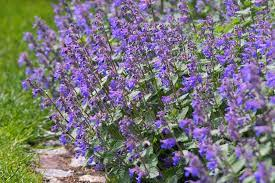 |
Faassen’s catnip (Nepeta faassenii)
Nepeta x faassenii is a hybrid of Nepeta racemosa and Nepeta nepetella. It produces purple flowers that attract lots of bees and butterflies. Cats are also very attracted to Faassen’s catnip. They eat it or rub against it and it has a drug-like effect, making them very playful and excited. Some cats are affected much more than others.
|
 |
Oleander (Nerium oleander)
Oleander is a commonly grown ornamental plant. It is so widely cultivated that its origin is unknown. The name Oleander comes from the plant’s resemblance to the olive plant Olea, but they are not related. Oleander was the first plant to bloom after the atomic bomb was dropped on Hiroshima in 1945, so it became the city’s official flower. Oleander is one of the most poisonous plants that is commonly grown. Every part of the plant is poisonous. The toxins can cause vomiting, abdominal pain, fast or irregular heartbeat, and nerve symptoms like tremors and seizures. If enough is ingested, it can lead to death. |
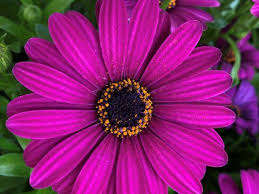 |
African Daisy (Osteospermum)
Osteospermum is native to South Africa and is commonly known as African Daisy, Blue-Eyed Daisy, and Cape Daisy. The genus name Osteospermum comes from the Greek ‘osteo,’ meaning ‘bone,’ and the Latin ‘spermum,’ meaning ‘seed.’ The name refers to the hard seed. The flowers can be white, purple, pink, or yellow.
|
 |
Cape Fuchsia (Phygelius x rectus ‘Moonraker’)
Cape Fuchsia is a hybrid of two species that are native to South Africa. It has dark green leaves and pale-yellow flowers. The flowers are long, narrow, and tube-like and they hang down from the stem. Hummingbirds are very attracted to Cape Fuchsia.
|
 |
Canary Island Pine (Pinus canariensis)
The Canary Island Pine is native to the Canary Islands. It cannot tolerate cold, but it warm temperatures it tolerates drought very well. This species is very important to the water cycle of the Canary Islands. The long needles help capture water coming off the ocean, which helps replenish the underground aquifers.
|
 |
Italian Stone Pine (Pinus pinea)
Italian Stone Pine, also known as Stone Pine, Umbrella Pine, and Parasol Pine, is native to the Mediterranean region. The tall trunk and broad branches at the top of the tree give it an umbrella shape. Italian Stone Pine has been cultivated for over 6000 years for the pine nuts. These were often used for trading and were considered a delicacy by Roman soldiers.
|
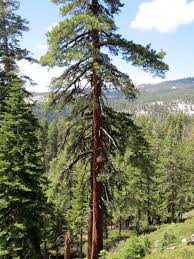 |
Ponderosa Pine (Pinus ponderosa)
Commonly known as Ponderosa Pine, Bull Pine, or Blackjack Pine, Pinus ponderosa is Native to western North America. It was first recorded in 1826 in Washington and is now the state tree of Montana. Like many pine species, the Ponderosa Pine has adapted to wildfires by developing very thick bark. These trees are used as a major source for lumber.
|
 |
California Foothill Pine (Pinus sabiniana)
California Foothill Pine is native to California. It has many common names including Gray Pine, Ghost Pine, and Bull Pine. Names like Gray or Ghost Pine refer to the grayish-green foliage. The tree produces edible pine nuts that were used as a food source by some Native Americans. The needles are the sole food source for Gelechiid moth caterpillars.
|
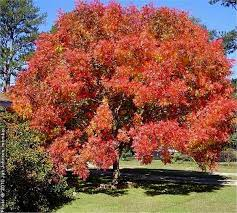 |
Chinese Pistache (Pistacia chinensis)
Native to China, the Chinese Pistachio is a very durable tree that can survive very bad conditions and poor soil. It is a popular ornamental tree because the leaves turn bright orange and red in the autumn. In China, the seed oil is used to make biodiesel. The wood is often used to make furniture and yellow dye.
|
 |
Pittosporum (Pittosporum)
Pittosporum is a genus of over 200 species. Commonly known as Cheesewood or Pittosporum, this genus is native to Australia, Africa, and Asia. It produces a woody fruit with lots of sticky seeds insides. The flowers have five petals and smell very sweet.
|
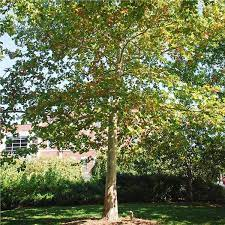 |
London Plane Tree (Platanus x acerifolia)
Thought to be a hybrid of the Oriental Plane Tree and American Sycamore, the London Plane Tree was first developed in the 17th century in Spain. It is very tolerant of pollution and cramped root space, which makes it ideal for planting along urban roadsides. London Plane Trees make up 10% of the trees planted along streets in New York City.
|
 |
Cottonwood (Populus sect Aigeiros)
Cottonwoods are in the Aigeiros section of the Populus genus. They are native to North America, the Aigeiros region of Greece, and Western Asia. They have cotton-like structures which carry their seeds through the air. This allows them to travel very far before settling on the ground. Cottonwood is sometimes used as cheap lumber. Because these trees are very tolerant of flooding, they are sometimes grown along riverbanks, where they can grow very quickly.
|
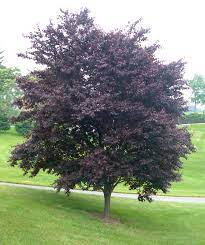 |
Purple Leaf Plum (Prunus cerisifera ‘Krauter Vesuvius’)
The Purple Leaf Plum is native to western Asia. It is often used as an ornamental tree because of its purple leaves and its pink flowers that bloom in early spring. The tree rarely produces plum-like fruits, but they should not be eaten because they are poisonous.
|
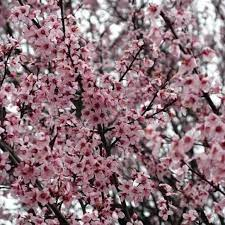 |
Flowering Plum (Prunus blireiana)
Prunus blireiana is a hybrid species developed in Blere, France. It blooms in early spring with fragrant pink flowers and then produces edible plums. Since it blooms so early in the spring, sometimes there are not enough pollinators, and it does not produce fruit.
|
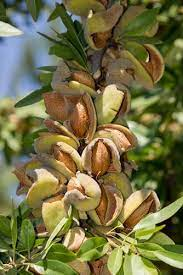 |
Almond Tree (Prunus dulcis)
The Almond Tree is native to the Middle East and southern Asia. It is the closest relative of the peach. Almonds are thought to be one of the first tree nuts to be domesticated. They are important in many cultures and are mentioned several times in the Bible. Almond Trees bloom in early spring, which is regarded in the Old Testament as a reminder that God is watching.
|
 |
Holly-Leaf Cherry (Prunus ilicifolia)
Also known as Evergreen Cherry, the Holly-Leaf Cherry is native to southern California. It blooms in early spring with small white flowers that attract bees. It produces small, sweet cherries, which Native Americans used to ferment to create an intoxicating drink. For hundreds of years, the Holly-Leaf Cherry was cultivated as a food source.
|
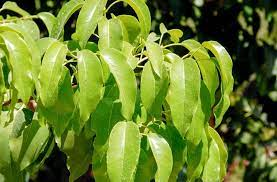 |
Catalina Cherry (Prunus ilicifolia spp. lyonii)
The Catalina Cherry Tree is native to southern California. It produces dark, edible cherries that attract lots of birds. The cherries used to make up an important part of the diet of some Native Americans.
|
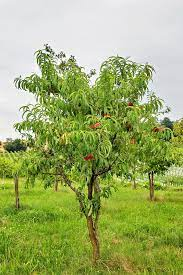 |
Peach Tree (Prunus persica)
Peach Trees are native to China and southern Asia. They were widely cultivated in Persia, which is how they got the species name persica. In Korea, peaches are the fruit of happiness, riches, and longevity. In ancient China, people put peach branches over their doors to protect them from evil spirits.
|
 |
Coast Live Oak (Quercus agrifolia)
The Coast Live Oak is native to California and is the only oak native to California that does well in coastal environments. Because of the occasional wildfires in California, Coast Live Oaks have developed thick bark to protect them from fire. California Oak Moth caterpillars use the Coast Live Oak as their sole food source. Every 8-10 years, lots of caterpillars come and eat all the leaves. Coast Oak acorns were a very important food source to many Native American tribes. They ground the acorns into powder and then washed them in streams to get rid of the bitter tannins.
|
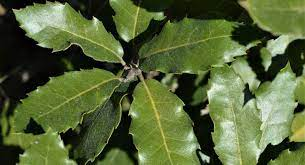 |
Holly Oak (Quercus ilex)
The Holly Oak is native to the Mediterranean region. The wood has been used in construction since ancient times for things like tools, wagons, and wine casks. It is also one of the best trees to search under for truffles. Ancient Greeks used the leaves of Holly Oak to tell the future. They also believed that the acorns were a sign of fertility and wore acorn jewelry to improve their chances of being fertile. |
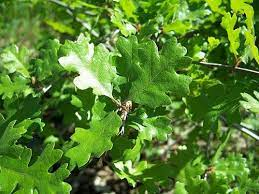 |
Valley Oak (Quercus lobata)
Valley Oak, which is native to California, is the largest North American oak. It can live up to 600 years, reach a height of 100 feet, and grow up to 10 feet in diameter. The trees provide a habitat for many birds and the acorns provide food for birds and squirrels. Gall wasps often lay eggs at the base of buds on the branches. This causes growths called oak apples, which provide protection for the larvae.
|
 |
Interior Live Oak (Quercus wislizenii)
The Interior Live Oak is native to California. It produces acorns every 5 to 7 years, which provides a food source for many animals. These trees are not as fire resistant as many other California natives. The bark is not particularly, thick, so the trunk is relatively easily killed by a fire. Instead, these trees survive by sprouting new growth from the roots. Because of this, the root systems of Interior Live Oaks can be much older than the trunk.
|
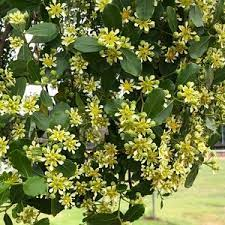 |
Soapbark Tree (Quillaja saponaria)
The Soapbark tree is native to Chile. When the inner bark is ground up into powder, it lathers up with water and can be used in place of soap. Though it can be poisonous if too much is ingested, people in the Andes have a long used the tree to treat chest problems. An extract called quillaia is used as a food additive and in products like pharmaceuticals, cosmetics, and fire-fighting foam.
|
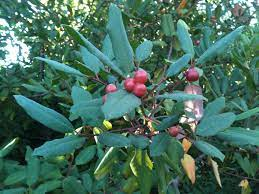 |
Coffeeberry (Rhamnus californica)
Also known as California Buckthorn, Coffeeberry gets its name from its small seeds that resemble coffee beans. Coffeeberry is an evergreen shrub with small white flowers and small, edible fruits. It is native to California and Oregon and Native Americans in these areas used to pick the fruit for use as food and medicine. Native Americans used the berries to induce vomiting, as a laxative, or as a topical treatment to stop bleeding and heal wounds or burns. Coffeeberry can also be used to soothe rheumatism. |
 |
Rose (Rosa)
Rosa is a genus that includes over 100 species. Roses are shrubs with sharp thorns that are often grown ornamentally for their beautiful flowers and nice scent. Rose oil is used to make perfumes and Roses are also used to make teas or flavor foods. In the Victorian language of flowers different colors of Roses have meanings. For example, a red Rose means love, a pink Rose means grace, and an orange Rose means passion.
|
 |
Rosemary (Rosemarius officianalis)
Rosemary is a fragrant shrub in the mint family. The leaves are used as a spice and the oil is used to add fragrance to perfumes, shampoos, incense, and other products. Rosemary has long been thought to improve memory, so in the Middle Ages it became associated with fidelity and was sometimes worn by the bride, groom, and guests during weddings. Sometimes a newlywed couple would plant Rosemary. If it flourished, it was a good omen for their marriage. Rosemary was also a symbol of remembrance, so it was often placed in graves during funerals. People also sometimes planted Rosemary outside their homes to ward off witches. |
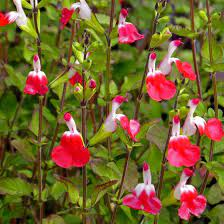 |
Hot Lips Salvia (Saliva ‘Hot Lips’)
Hot Lips Salvia was discovered in Mexico. It produces white flowers with red at the tips. When the weather gets hot, the flowers turn all red or sometimes all white, but then go back to being two colors in the fall. The flowers attract butterflies and hummingbirds.
|
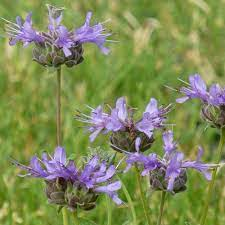 |
Pozo Blue Sage (Salvia ‘Pozo Blue’)
Pozo Blue Sage is a hybrid of two species native to California. It is drought tolerant and has grayish green leaves that smell like citrus. Pozo Blue Sage produces purplish blue flowers that attract bees, butterflies, and hummingbirds.
|
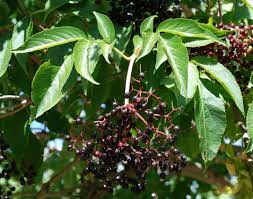 |
Mexican Elderberry (Sambucus mexicana)
Mexican Elderberry blossoms in late spring. The tiny white flowers attract lots of bees and birds. In early summer, it produces clusters of purple berries. These edible berries are used to make pies, wine, and jam as well as blue dye. Native Americans used the flowers to make tea to soothe fevers and a topical treatment to soothe itching and pain. The branches of the Mexican Elderberry were used to make bows and flutes. The name Sambucus comes from an instrument called sambuke. |
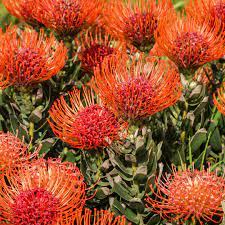 |
Pincushion Flowers (Scabiosa)
Pincushion Flowers are native to Europe and Asia. They have many small lavender, blue, or white flowers with long stamens that stick out from the flower like pins. The flowers attract moths, butterflies, and birds.
|
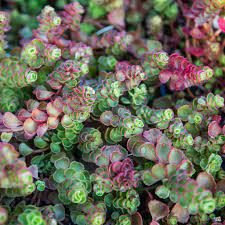 |
Dragon’s Blood Sedum (Sedum coccineum)
Dragon’s Blood Sedum is a perennial stonecrop that produces bright red flowers in late summer. It can tolerate all kinds of conditions, including heat, cold, humidity, poor soil, and drought.
|
 |
(Senecio)
Senecio is a genus of over 1250 species. It includes many Ragworts and Groundsels. They produce clusters of white, yellow, red, or purple flowers at the tip of the stem. These plants also contain toxins that affect humans, livestock, and many other animals.
|
 |
Coastal Redwoods (Sequoia sempervirens)
Coastal Redwoods are native to California. They grow well in areas with summer fog because it saves them from dehydration. Because these trees don’t produce resin, they are very fire resistant. They are also decay resistant, so they were often used to build railroads in California. Sprouts grow at the base of adult trees and when the parent tree dies, the sprouts grow up into a ring of trees called a ‘fairy ring.’ |
 |
Lamb’s Ear (Stachys byzantia)
Lamb’s Ear, which is native to Turkey, Armenia, and Iran, is named for the soft, fuzzy leaves that feel like lamb’s ears. It has spikes with small, pink or white flowers that bloom in late spring. Though it is no longer used medicinally, it has antimicrobial properties and was once used to treat wounds.
|
 |
Giant Feather Grass (Stipa gigantea)
Giant Feather Grass is a bunchgrass native to southern Europe. It has narrow, grayish green blades and tall stems that bear the feathery brown flowers. The flowers look like oats, which is why this plant is also sometimes called Golden Oats.
|
 |
Japanese Pagoda (Styphnolobium japonicum)
Despite the name, the Japanese Pagoda is native to China and Korea, not Japan. It is a popular decorative tree because it blooms in late summer. The tree has traditionally been used for its anti-inflammatory, anti-bacterial, and antioxidant properties, though these have not been scientifically proven.
|
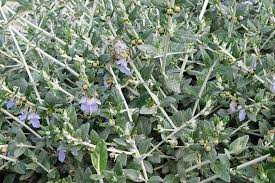 |
Bush Germander (Teucrium fruticans)
Bush Germander is native to the Mediterranean and is a member of the mint family. It has silvery green leaves and produces purple flowers. Teucrium may have been named after King Teucer of Troy, who is thought to have used this plant for medicinal purposes.
|
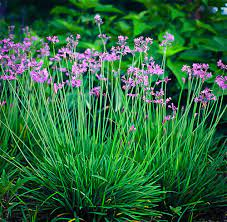 |
Society Garlic (Tulbaghia violacea)
Society Garlic, also known as Pink Agapanthus, is a member of the lily family that is native to South Africa. The leaves smell like garlic and are edible, as are the flowers. The name Society Garlic comes from the belief that eating society garlic doesn’t make your breath smell bad like garlic would. The purple flowers attract bees, butterflies, and moths.
|
 |
Elm (Ulmus)
Elms can grow to be 100 feet tall and 3 feet in diameter. Elm wood is heavy and hard and is used to build furniture and other products.
|
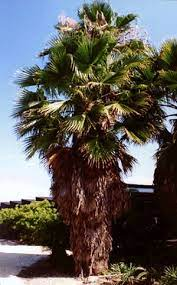 |
Washington Palm (Washingtonia robusta)
Also known as Mexican Fan Palm and Mexican Washingtonia, the Washington Palm is native to Mexico. It has fan-like leaves and a very tall, narrow trunk that can get up to 100 feet tall. It is very drought and salt tolerant.
|
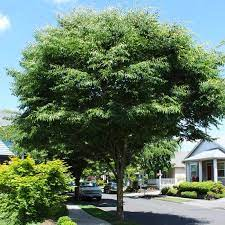 |
(Zelkova)
Zelkova is a genus in the Elm family and is native to Asia and southern Europe. The wood is very hard and is used for building and furniture making.
|
 |
Morning Glory
Over 1000 species in the family Convolvulaceae are referred to by the common name Morning Glory. They produce funnel-shaped red, white, yellow, purple, or blue flowers. In most species, the flowers open early in the morning and close back up when it gets too warm. In the 1600s, Morning Glories became very popular in Japan. Many varieties were developed there, and the flower came to symbolize summer in Japanese art. In the Victorian language of flowers, Morning Glories mean ‘love in vain.’ In China, Morning Glories were once used medicinally. The seeds of some species contain psychedelic substances that have an effect similar to LSD. This was sometimes used by Aztec priests in Mexico. |
Swale Plants
California Brome (Bromus carinatus)
California Brome is a bunchgrass native to the United States. It is commonly grazed by livestock, big game, rodents, and birds. It is not very fire resistant, but it is a pioneer species, meaning that it establishes itself very quickly in an environment that has recently been cleared by fire or other environmental disruptions. Some Native Americans believed California Brome seeds were poisonous if swallowed whole, but they ground the seeds into flour to make bread.
California Fescue (Festuca californica)
California Fescue is a blue-green grass native to California and Oregon. Its deep roots make it drought tolerant. This species attracts butterflies, ladybugs, and birds.
Idaho Fescue ‘Siskyou Blue’ (Festuca idahoensis)
Festuca idahoensis is a grass native to western North America. It is commonly called Idaho Fescue or Blue Bunchgrass. It has a bluish green color and can grow up to three feet. This grass is very tolerant of drought and poor soils. It is a major source of food for some domestic livestock as well as elk, deer, and other big game.
Molate Red Fescue (Festuca rubra ‘Molate’)
Molate Red Fescue is a grass native to California. It is dark green with red near the base. It grows well in the shade and attracts lots of birds.
Baltic Rush (Juncus balticus)
Baltic Rush is a wiry grass that can grow up to three feet. Because it is so wiry, animals do not eat mature plants, but they sometimes graze young ones. Native Americans used Baltic Rush to weave baskets and make dyes.
Soft Rush (Juncus effusus)
Soft Rush is native to the west coast of the United States. It grows in wet areas.
California Gray Rush (Juncus patens)
California Gray Rush is native to the west coast of the United States. It is a gray-green rush that grows 1.5-2 feet tall and is found in wet areas.
Deergrass (Muhlenbergia rigens)
Deergrass is native to the southwestern United States and Mexico. It is a bunchgrass that can reach three feet long. It can be silver-green, green, or purplish and is very drought tolerant. Young plants are sometimes grazed by animals, but despite the name, deer do not eat it very much. Native Americans often used Deergrass for basketweaving and cultivated it for this purpose.
Alkalai Sacaton (Sporobolus airoides)
Also known as Finetop Saltgrass and Hairgrass Dropseed, Alkalai Sacaton is native to the United States from the Midwest to the west coast. It is drought tolerant and grows well in alkaline and saline soils. Cattle, sheep, and other livestock often graze on Alkalai Sacaton.
Scent Garden
The Davis Cemetery District’s scent garden is full of interesting plants, many of which are edible as herbs and teas. The scent garden is designed so that each plant comes right to the outer edge, where they can easily be enjoyed by both sighted and non-sighted visitors.
To find the scent garden from the office, walk out of the office to the road in front of the flagpole. Go south along the road for 220 feet until you see the signpost with the letter D on it. From the D marker, walk 150 feet west, where you will see the Sorbello gravestone. Directly to the south, you will see the coping which contains the scent garden.
Starting in the northwest corner, you will find Nutmeg Scented Geraniums (Pelagornium x Fragrans). These were often used in Victorian flower bouquets to mean “expected meeting.”
On the east and south sides of the Geraniums, you will find Lemon Balm (Melissa officinalis). The genus name Melissa comes from a religion in ancient Ephesus (modern Turkey), which was based on the life of the bee. The Goddess was the queen bee and her priestesses were called Melissai. In ancient Greece, Melissai served the Goddess of Earth and Nature (Artemis). Lemon Balm was often planted at the temple of Artemis because it attracted so many bees and got its name from the Melissai.
Today, Lemon Balm is used as flavoring and has been shown to be effective against some kinds of viruses. It is being studied further to determine its effectiveness in fighting Grave’s disease, hyperthyroidism, and dementia.
Moving east from the Lemon Balm, you will find French Thyme (Thymus vulgans). Common Thyme has many varieties, including French, German, English, and many cultivars. It is often used as a cooking spice. Ancient Greeks sometimes put Thyme on coffins because they believed the spirit would be absorbed and live happily in the flowers of the plant. In medieval times, Thyme was a symbol of courage. Women embroidered scarves with a sprig of Thyme to give to knights leaving to fight in the Crusades. Tea made with Thyme was also thought to prevent nightmares, and some believed it allowed you to see nymphs and fairies. Herbalists in the Middle Ages believed that Thyme had stimulant and antispasmodic properties and recommended sleeping with and inhaling Thyme as treatment for melancholy and epilepsy.
Today, Thyme is used as an antiseptic, digestive aid, and antispasmodic, and the thymol from its oil can be used to treat burns, eczema, parasites, and is often used as an ingredient in toothpaste and mouthwash.
In the middle of the north side of the coping is a section of Pineapple Mint (Mentha Suaveolens). This plant is often used in pot pourri and as a food garnish. In ancient Greece, mint was a symbol of hospitality and was rubbed on tables before they were set for dinner guests.
Moving east, after another section of French Thyme, you will find Perennial Marigolds (Tagetes lemmonii). Also called Copper Canyon Daisies, this plant is native to Arizona and northern Mexico. Its strong scent repels deer, but attracts bees and butterflies.
In the northeast corner, you will find Marjoram (Origanum majoricum). In some areas of the Middle East, marjoram is synonymous with Oregano. The names “Sweet Marjoram” and “Knotted Marjoram” are used to distinguish it from other species in the genus Origanum. The Greeks and Romans considered Marjoram to be a symbol of happiness. It was sometimes planted by graves to make sure the spirits would be happy and peaceful. They also believed that if you smeared Marjoram on yourself, you would dream of your future spouse. In the Middle ages, couples getting married wore Marjoram as a symbol of love, honor, and happiness.
On the east side of the garden, south of the corner, there is another section of Perennial Marigolds. Continuing south, you will see Silver Thyme (Thymus argenteus). This cultivar of common Thyme has leaves with silver around the edges. The flowers can be dried and used to protect linens from insects.
In the middle of the east side of the garden, you will find Chocolate Mint (Mentha piperita). The name comes from its similarity to chocolate mint candy.
South of the Chocolate Mint, after another section of Silver Thyme, there is some White Horse Lavender (Lavendula angustifola). The fragrant flowers of Lavender attract lots of bees, butterflies, and birds. This species was formerly known as Lavendula officinalis, meaning “lavender of the shops,” because it was sold in shops for medicinal purposes. Lavender is thought to have many therapeutic properties, including relaxation, getting to sleep, stimulating blood flow, and fighting depression and headaches. Lavender’s oils and petals are also used in many cosmetic products such as lotions and shampoos.
In the southeast corner, you will find Tarragon (Artemisia dracunculus). It was given the name “dragon herb” because of its serpent-like roots, which also gave rise to the belief that it would cure snake bites. Tarragon is often used in cooking and is even considered to be ‘king of the herbs’ in France. It also has many medicinal uses. Due to its anesthetic properties, it was used by the Greeks to relieve toothaches. It has also been used to aid digestion, stimulate appetite, and treat colic and arthritis.
On the south side of the garden, west of the Tarragon is another section of Lavender. Further west, you will find Lemon Mist Thyme (Thymus x citriondorus). The leaves, which smell like citrus, are often used in antiseptics and disinfectants.
In the middle of the south side, there is another section of Pineapple Mint. West of that, there is some more Lemon Mist Thyme. Then you will see the Dwarf Curry Plant (Helichrysum italicum nana). This plant smells strongly of curry, though it is not used to cook curry dishes. Essential oils from this plant are often used to make perfumes and cosmetics
In the southwest corner, you will find Salad Burnet (Sanguisoria minor). This plant is native to Europe and was brought to the New World by pilgrims. It tastes and smells much like cucumber and is often used in salads and other dishes. The name Sanguisoria minor can be loosely translated from Latin as “blood absorber,” which refers to its astringent qualities. With this in mind, soldiers during the American Revolution drank tea made from Salad Burnet in the hopes that if they were wounded in battle, their bleeding would not be too severe. In 16th century England, it was also used to treat rheumatism and gout, and in the 17th century, it was recommended to protect people against the plague and other diseases.
On the west side of the garden, there is another section of Dwarf Curry Plant next to the Salad Burnet. North of that, you will find Caraway Thyme (Thymus herba-barona). This plant is native to Corisca, Sardinia, and Majorca and is named for its scent’s similarity to Caraway.
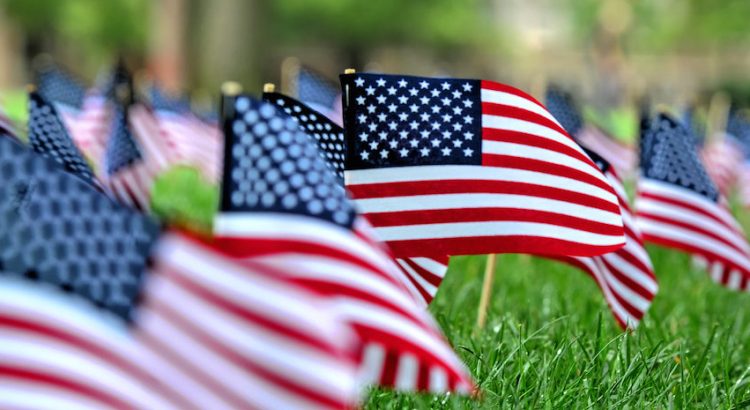
Veterans Day November 11th
The Davis Odd Fellows and Davis Canton will host this year’s Veterans Day ceremony Friday, November 11th, at the Davis Cemetery District, 820 Pole Line Road.
There will be a musical prelude at 9:30 am followed by a formal program beginning at 10:00 am. The ceremony will include a Posting of the Colors by UC Davis Army ROTC, musical selections, and keynote speaker Larry Guenther.
Keynote Speaker Biography: Coming Soon!
Davis Scouts and cemetery staff will place the flags along our internal roadways and on the graves of nearly 1,000 veterans buried at the cemetery.
If you are interested in volunteering for setting up or to aid in the handing out of programs and the removal of flags later in the afternoon, please contact Jessica at jess@daviscemetery.org.

Dia De Los Muertos at the Davis Cemetery District
The community is invited to the annual Dia de los Muertos Celebration from 11 a.m. to 3 p.m. Saturday, Oct. 27th, at the Davis Cemetery, 820 Pole Line Road.
This celebration is one of the last Mesoamerican indigenous influenced rituals, honoring mother earth and all ancestors. This celebration is part of an effort to create a community, a sense of belonging, and global awareness of cultural richness in a multicultural society.
The festivities will include Danza by Kulpulli Tlayolotl, Mariachi Puente, and much more.
Traditional hot chocolate and pan dulce treat also will be provided. The event is free but donations are welcome and appreciated.
There will be a collective altar honoring all ancestors. This event is free and open to the public and everyone is welcome to contribute to the altar or create their own.
This year we are seeking sponsors if you are interested in sponsoring this event. Please, Kristi Dvorak at cemcod@dcn.org.
For more information or to display an altar on Oct. 27, contact event co-coordinator Melissa Moreno at mmmorenophd@gmail.com or Christi Postlethwaite cemoffmgr@dcn.org
**
Davis Cemetery History, Plant and Bird Lists
The Davis Cemetery District is the oldest cemetery in Yolo County. It was founded in 1850 on donated farm land by one of the region’s pioneer families. The earliest grave marker in today’s Cemetery District date back to 1855. The cemetery was incorporated into a special district with tremendous support from the residents in 1922. Dedicated volunteers planted trees, mowed the grass and transformed the space into a garden park cemetery.
Davis Cemetery Arboretum Bird List
Davis Cemetery District Agendas
2023 Davis Cemetery District Agendas
January 2023 – No Meeting Scheduled
February 2023 – Zoom login here. Meeting ID: 831 3340 8454 Passcode: 338008
March 2023 – No Meeting Scheduled
2022 Davis Cemetery District Agendas
January 2022 – No Meeting Scheduled
February 2022 – Zoom login here.
March 2022 – No Meeting Scheduled
May 2022 – No Meeting Scheduled
July 2022 – No Meeting Scheduled
August 2022 – Zoom login here. Meeting ID: 838 2778 9731 Passcode: 930802
September 2022 – No Meeting Scheduled
October 2022 – Zoom login here. Meeting ID: 860 2187 6433 Passcode: 443139
November 2022 – No Meeting Scheduled
December 2022 – Meeting Canceled due to lack of action items
2021 Davis Cemetery District Agendas
January 2021– Zoom login here.
February 2021 – Meeting Canceled
March 2021 – Zoom login here.
April 2021 – Zoom login here.
May 2021 – Meeting Canceled
July 2021 – No Meeting Scheduled
August 2021 – Zoom Login here.
September 2021 – No Meeting Scheduled
October 2021 – Zoom Login here.
November 2021 – No Meeting Scheduled
December 2021 – Zoom Login here.
2020 Davis Cemetery District Agendas
January 2020 – Canceled due to weather
April 2020 – Canceled due to Shelter @ Home Order
November 2020 Zoom Login Here.
2019 Davis Cemetery District Agendas
January 2019 – the meeting was canceled due to the weather
November 2019 – Meeting canceled
2018 Davis Cemetery District Agendas
July 2018 Special Meeting Agenda





























